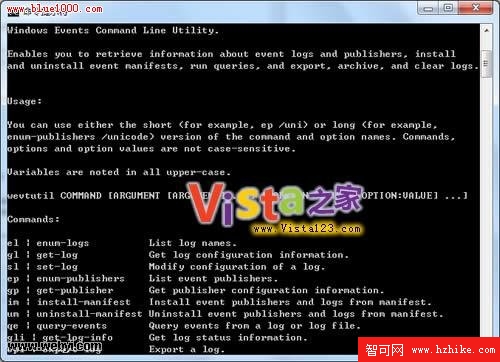如果有一個,一個朋友對你說他的電腦出現了問題,可能,你需要去分析它的系統的事件日志。畢竟,在Windows系統裡面,系統事件日志裡面記錄了太多的信息,應用程序的使用、崩潰等記錄,Windows系統的各種事件記錄等等。然而,當你的朋友把他的Windows目錄下的日志發過來,你想進行查看分析的時候,卻發現,提示事件日志崩潰!
這是怎麼回事呢?
原因很簡單,Vista之前事件日志是.evt文件,Vista及之後是.evtx文件!
我們可以用微軟提供的Log Parser 2.2(點擊進入微軟官方頁面),它能在相應的系統上解析各自支持的格式,解析命令為:
logparser -i:EVT "SELECT * INTO a.csv FROM b.evt"
但如果在Vista、Windows Server 2008、Windows7及之後系統上解析.evt格式日志可能會提示事件日志崩潰,這時需要將.evt格式轉換為.evtx格式,幸運的是Vista及之後的系統提供了Wevtutil-Windows Events Command Line Utility這個工具!
運行命令:wevtutil epl application.evt application.evtx /lf:true 就能轉化。

wevtutil 在系統裡面的提示都是英文,:
Windows Events Command Line Utility.
Enables you to retrIEve information about event logs and Publishers, install
and uninstall event manifests, run querIEs, and export, archive, and clear logs.
Usage:
You can use either the short (for example, ep /uni) or long (for example,
enum-publishers /unicode) version of the command and option names. Commands,
options and option values are not case-sensitive.
Variables are noted in all upper-case.
wevtutil COMMAND [ARGUMENT [ARGUMENT] ...] [/OPTION:VALUE [/OPTION:VALUE] ...]
Commands:
el | enum-logs List log names.
gl | get-log Get log configuration information.
sl | set-log Modify configuration of a log.
ep | enum-publishers List event publishers.
gp | get-publisher Get publisher configuration information.
im | install-manifest Install event publishers and logs from manifest.
um | uninstall-manifest Uninstall event publishers and logs from manifest.
qe | query-events Query events from a log or log file.
gli | get-log-info Get log status information.
epl | export-log Export a log.
al | archive-log Archive an exported log.
cl | clear-log Clear a log.
Common options:
/{r | remote}:VALUE
If specifIEd, run the command on a remote computer. VALUE is the remote computer
name. Options /im and /um do not support remote Operations.
/{u | username}:VALUE
Specify a different user to log on to the remote computer. VALUE is a user name
in the form domain\user or user. Only applicable when option /r is specifIEd.
/{p | passWord}:VALUE
PassWord for the specified user. If not specifIEd, or if VALUE is "*", the user
will be prompted to enter a passWord. Only applicable when the /u option is
specifIEd.
/{a | authentication}:[Default|Negotiate|Kerberos|NTLM]
Authentication type for connecting to remote computer. The default is Negotiate.
/{uni | unicode}:[true|false]
Display output in Unicode. If true, then output is in Unicode.
To learn more about a specific command, type the following:
wevtutil COMMAND /?